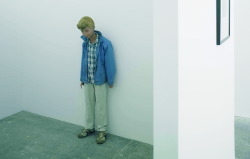Before the End

Beginnings matter. Andy Warhol declared that he wanted to make all his works look like his first. Stanley Kubrick bought back every copy of his first feature-length film so that no one would see it. Marcel Duchamp scholars are pillaging flea markets for anything that could have been made before the earliest known piece by the master. In a world of retrospective studies and art world speculations invested in the progression of style, the moment when the beginning began is loaded.
But how to determine which one is actually the first work? The two-part show at Le Consortium (really two exhibitions, with an imposing, forgettable display by Eric Troncy in between) took this question as its subject. In the first section curator Stephanie Moisdon invited about 20 artists (inspired for the most part by Conceptual art) to display and discuss their very first work of art. 'I chose the project Hyper Hyper (1989) because it was one of the first after Siberia (1989) in which we used real information', wrote Pierre Joseph of his contribution. 'First' it seems, is an adjective of considerable elasticity and not always indicative of interesting work.
In some cases, however, the fertile seeds of later preoccupations were in evidence. Carsten Höller's youthful aviary collection Bird Collection (1972-7) bore all the signs of the scientific fascination and doubt that permeate Höller's works now (he had even measured and labelled the bones of the birds' heads to determine their approximate age). The art world's fashionista Sylvie Fleury, echoing her mum's taste for
luxury, presented her mother's leather Hermès handbag on a pedestal (Untitled Untimed Sometime Somehow Drivin Now, undated). Among the earliest works in the show, Dan Graham's Figurative (1965) appeared in two parts: a maquette with ordinary store receipts collaged in a column and, alongside it, the Harper's Bazaar spread in which this supposedly first work was first published. But a quick glance showed that the numbers didn't match: the collaged receipts weren't the same as those reproduced in the magazine. And between 'original' and published copy, Graham's first work may have been the Conceptual premise that a document could be a fiction. Other artists such as Hans-Peter Feldmann didn't send a work at all, asking instead that a ready-made mannequin of a ten-year-old child be found for him, titled Franz (2003) and placed in a small, dimly lit room.
A bit like Feldmann's impish doppelgänger, the exhibition idea was novel, including, as it did, works that some might prefer to forget. It was up to the second, smaller, section to explore the notion of beginnings differently. Swiss artist Olivier Mosset asked a handful of artists to show the paintings they had made in the 1960s, just before each of them began to make the Conceptual art for which they would become known. Not 'first' works, then, strictly speaking, but ones that render the definition of beginning and ending nebulous. Reverentially hung in a space as sparse as most of the works themselves, the eight canvases shared a palpable restlessness. Poised like swimmers on a diving board, their pool was an idea without predetermined material or form. Joseph Kosuth showed a hesitant grid on a blackish monochrome, Post-Painting (1963-4), already 'post' but painted before the artist's discovery of New York, Ludwig Wittgenstein or his signature language-based style. The members of Art & Language, before they called themselves by that name, reduced painting to the figuration of information with grey canvases bearing the words 'Painting' and 'Sculpture' in Painting-Sculpture (1965) or, slightly later, in rows of stencilled percentages for 100% Abstract (1968). The use of paint and canvas quickly fell away but the group's obsession with numbers and words was already there. Robert Barry's palm-sized monochrome Untitled (1967) is so small it seems to reveal the wall on which it hangs rather than vice versa - dematerialization doesn't seem so far away, and the door to rooms filled with nothing more than carrier waves opened only a year later.
Is the last painting before making an art of pure ideas already the demise of painting as such? The beginning, as both exhibitions showed, is a foggy threshold that simply comes before the end.
















